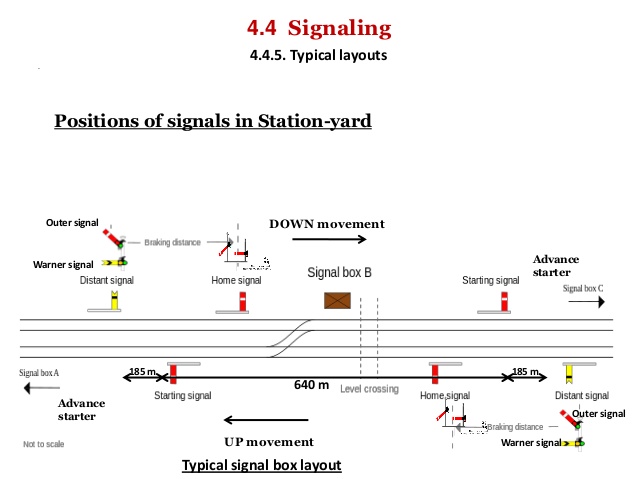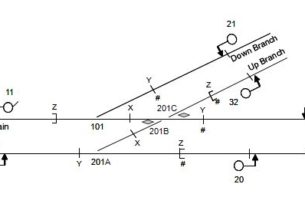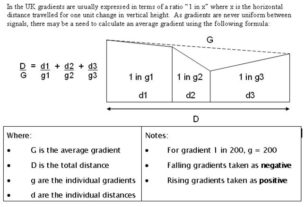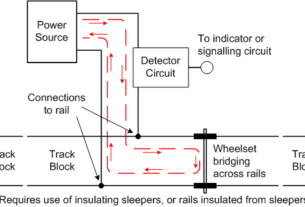Railway Signalling layout of signal positioning
GK/RT0032 – Provision of Lineside signals
This document defines the mandatory requirements for the provision of lineside signals and the sequences in which signal aspects shall be presented to train drivers, in respect of plain line, diverging junctions and for bi-directional lines, to enable them to
- a) stop safely at a signal at danger
- b) regulate train speed to negotiate junctions safely
- c) regulate train speed to that of an immediately preceding train
Signal Designation: The terms “passable and non passable” apply for operating purposes, and “Automatic/Controlled” for signal control system purpose.
Automatic: A signal which does not require specific action by a signaller or automatic route setting equipment in order to show a proceed aspect.
Controlled: A signal that requires a specific action by a signaller or automatic route setting equipment on each occasion that it is required to show a proceed aspect (other than when a signal is arranged to work automatically)
Railway Signalling layout of signal positioning
Required reading time:
It is the sum of
- a) the time that is necessary for a driver approaching a signal to achieve the following.
1) identify the signal that is applicable to the driver.
2) observe the information presented by the signal.
3) interpret the information to determine what action, if any, is required.
- b) such additional reading time as is reasonably practicable to provide.
Required reading time is specific to each individual signal and is not applicable where all trains start from rest.
Signal spacing: The distance between the signal or lineside sign displaying the first cautionary aspect and the signal or lineside sign at which the train is required to stop.
Stop Signal: The word “signal” includes not only colour light and semaphore signals, but also any lineside sign that performs that function of a signal. for the purpose of lineside signals, the term stop signals also include shunting signals, stop boards, buffer stops and point set indicators.
Choice of signal type:
Running line: A stop signal that controls a running direction movement along or onto a running line shall be a main signal except shunting signal provided for the control of other than time tabled passenger train movements. It is permissible for such a shunting signal to become facing for running movements (operated as a preset shunt).
Sidings: A stop signal controlling movements into or along sidings shall be a shunting signal, unless other considerations require it to be a position light aspect on a main signal.
Block signalling: In all forms of fixed block working, the entrance and exit of every signal section shall be denoted by a stop signal.
Facing junctions: A stop signal shall be provided on every line on which signalled movements can approach facing points, with the exception of train operated points equipped with points indicators.
Level Crossings: Where a level crossing to be protected by interlocked signals, a stop signal shall be provided on every line on which signalled movements approach the crossing
Conflicting movements: A stop signal shall be provided on every line on which signalled movements can approach an area of conflict.
Lockout Systems: Where a lockout system for the protection of trackside personnel is provided, a stop signal shall be provided on every line on which signalled movements can approach the area protected by the lockout system, positioned so as to protect the personnel making use of the system.
Signals at point of reversal:
Where trains are required to reverse on lines worked by track circuit block or absolute block, a stop signal (set back signal) shall be provided at the point of reversal to authorise the movement in the reverse direction.
Where practicable, the setback signal shall be positioned so that
- a) the whole of the train comes to a stand behind the signal after making the outward movement.
- b) when the outward movement has been completed, the distance between the end of the train and the siganl is minimised.
Ground Frames: Signals on running lines protecting ground frame points shall be controlled signals, designated non-passable. It is permissible for movements from running lines into entirely within sidings accessed by ground frame operated points to be controlled by hand signal.
Constraints on the positioning of stop signals
- Position of signals relative to facing points:
Where a signal reads over facing points, it shall be positioned not more than 800m from the first set of facing points, so that risk due to the following is minimised.
- a) the likelihood of the driver forgetting the indicated route
- b) the ability to accelerate to greater than the permissible speed over the diverging route.
The 800m limit does not apply to:
- a) points operated from Ground frame
- b) facing points which are out of use
- c) facing points which are in same position for movements from the signal
- d) a signal which is positioned parrallel with other signals and one of parallel signal within 800m of facing points.
- Position of signals relative to points & level crossing
Where stop signals shall be positioned so that,
- a) the associated overlap is clear of points, level
- b) trains stopped at the signal do not stand over points or level crossings or foul any other
Stop signals shall be positioned so that trains stopped at them do not stand over runaway catch points.
Constraints on positioning of stop signals
- Position of signals relative to platforms:
Stop signals shall be positioned to minimise the risk arising from passenger trains without central door locking or power operated doors stopping with a platform adjacent to only part of the train.
- Position of signals relative to the hazardous location:
- a) Where practicable, stop signals shall be positioned to avoid the risk of a passenger train stopping in a hazardous locations (eg: on a viaduct, or on a tunnel)
Where a signal is required in such a location, i.e to maintain headway, signalling controls shall be applied to the previous signal so as to minimise the risk of a train being brought to a stand at such location.
It is not necessary to apply such special controls whrere risks are adequately controlled by other means such as:
- b) Where practicable, stop signals shall be positioned such that the driver not exposed to hazards such as live c. traction rails when leaving the cab of a train stopped at signal.
- c) Stop signals shall be positioned so that the exposure of the driver to hazard whilst using the signal post telephone is minimized.
- d) On lines electrified with overhead systems, stop signals shall be appropriately positioned in relation to a neutral section or section gap.
Bi-directional signalling
- a) For every signal provided, there shall be a parallel signal for movements in the same direction on the adjacent lines. Refer GK/RT8037 for positioning of other signals.
- b) On bi-directional lines where a predominant (normal) direction of traffic is designated, it is permissible for signalling in the contra-flow direction to be three aspect. whilst that in the same (normal) direction on the adjacent line is four aspect, provided that a lower permissible speed is applied for contra flow direction
Identity of signals Signal numbering:
Each signal shall have an identity that is unique to its controlling signal box or locality, comprising the signal box prefix code, the signal number and where required, a suffix. The number of each signal worked by a lever shall be the same as the lever number
All signals , including automatic and distant signals, except distant signals worked from the same lever as a stop signal, shall be individually numbered as part of sequence. Separate sequence shall be used for running signals and shunting signals.
Signal numbering:
Except where signals are worked by levers, the rules for determining the sequence of numbers are as follows:
- a) The sequence of numbers shall be separate and distinct from other numbered functions such as points, ground
frame releases etc.
- b) The sequences shall be logical and rational and shall be
- c) Odd numbers shall be used for down direction signals and even numbers for up direction signals.
- d) Odd numbers shall usually ascend and even numbers descend in the direction of traffic flow.
- e) If there is more than one running line in each direction, the numbers for each line shall be in separate sequences.
Signal numbering:
- f) As far as possible train drivers shall be presented at successive signals with signal numbers which are consecutive odd or even numbers.
- g) Where up to five signals applying to traffic in the same direction are positioned side by side the last digit of each signal identity shall be different.
- h) Where more than five signals are positioned side by side, the last digit of the identities of adjacent signals shall be different
The following signal suffixes shall be used for the applications indicated:
BR- for banner repeating signal, the number being the same as that of repeated signal
CA- for co-acting signal, the number being the same as that of primary signal
R- solely for a distant signal worked form the same operating device as a stop signal, the number being the same as that of stop signal
RR- solely for an outer distant signal worked form the same operating device as a stop signal same as that of stop signal




